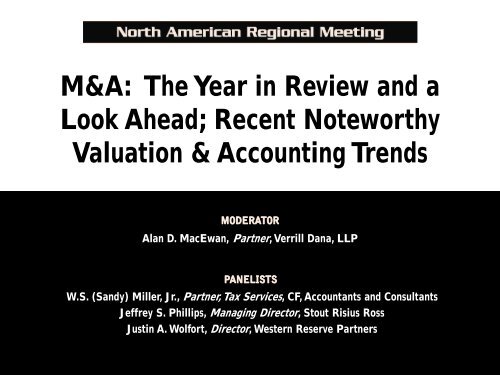Presentation - World Services Group
Presentation - World Services Group
Presentation - World Services Group
- No tags were found...
You also want an ePaper? Increase the reach of your titles
YUMPU automatically turns print PDFs into web optimized ePapers that Google loves.
199519961997199819992000200120022003M&A: The Year in Review and a Look Ahead200420052006200720082009201020112012Recap of 2012 – Market Recoveries: They Don’t Make Them Like They Used ToU.S. Middle Market M&A ActivityM&A Volume as a % of Market Cap(# of transactions) ($ in billions)9,0008,0007,0006,0005,0004,0003,0002,0001,0006,2037,0307,7668,428 8,5276,9865,6396,2996,5466,208$1,600$1,400$1,200$1,000$800$600$400$20012%10%8%6%4%2%1995 - 2012 Average: 6.7%5%02003 2004 2005 2006 2007 2008 2009 2010 2011 2012$00%Source: Thomson FinancialNumber of TransactionsDeal ValueSource: DealogicU.S. Announced M&A as a % of Market CapU.S. AverageGreat Expectations• Deal activity was strong in 2012, particularly in Q4, but overall fell short of expectations• M&A volume as a percent of total U.S. market cap in 2012 was almost 30% below the historical averageA Tale of Two Markets• A closer examination reveals a bifurcation of the “haves” and “have-nots” (companies with healthy margins andstrong growth stories versus those with weaker performance or less sophisticated technology)• Middle market LBO targets with above average financial performance accounted for 64% of middle market LBOactivity in 2012, compared to only 42% in 2009 11GF Data, February 2013CLEVELAND ● COLUMBUS ● DALLAS3
M&A: The Year in Review and a Look AheadRecap of 2012 – Valuation Trends: Synergy and Size Still Matter!Middle Market EBITDA Multiples(EV / EBITDA)10.0x9.0x8.7x8.3x8.2x 8.4x8.0x7.9x7.0x6.0x 6.0x6.0x6.8x6.0x 5.9x 6.1x 6.2x5.0x4.0x3.0x2.0x1.0x0.0x2007 2008 2009 2010 2011 2012StrategicFinancialSource: Capital IQ / GF Data * Middle Market = transaction enterprise value between $10 and $250 millionMiddle Market Private Equity EBITDA Multiples(EV / EBITDA)8.0x7.5x7.5x7.0x6.8x6.5x6.0x6.1x5.5x5.5x5.0x4.5x4.0x2007 2008 2009 2010 2011 2012$10 - $25 million $25 - $50 million $50 - $100 million $100 - $250 millionSource: GF Data*Middle Market = transaction enterprise value between $10 and $250 million• Strategic valuation premiums lessened as corporations pulled back and private equity firmscontinued to aggressively deploy their long-committed capital on quality businesses• However, a longer-term perspective and synergy creation allow strategic buyers to affordpremium valuationsCLEVELAND ● COLUMBUS ● DALLAS5
M&A: The Year in Review and a Look AheadRecap of 2012 – Cross-Border ActivityForeign Acquisitions in the U.S.(# of transactions) ($ in billions)U.S. Acquisitions Abroad(# of transactions) ($ in billions)2,0001,6001,8931,6801,538 1,501 1,501 1,454$500$4002,5002,0002,3621,9991,8091,8771,744$500$4001,200$3001,5001,440$300800$2001,000$200400$100500$10002007 2008 2009 2010 2011 2012$002007 2008 2009 2010 2011 2012$0Number of TransactionsDeal ValueNumber of TransactionsDeal ValueSource: Thomson FinancialSource: Thomson Financial• Cross-border M&A activity continued to cool in 2012 as the global financial crisis kept buyers at bay• U.S. companies continue to focus on building domestic capacity versus offshore investing• The compressing exchange rate of the U.S. dollar to key international currencies has cut into the“value” proposition of U.S. targets• Still mired in the Eurozone crisis and sovereign debt issues, coveted European assets present a valueopportunity for healthy foreign acquirorsCLEVELAND ● COLUMBUS ● DALLAS6
M&A: The Year in Review and a Look AheadRecap of 2012 – Private Equity Sectors in Favor: Who’s Hot and Who’s Not100%90%80%70%60%50%40%30%20%10%0%Financial Sponsor Activity (Percent of Deal Count)31% 33% 33% 33% 34%17% 17% 16%18%20%17%21%19%18%16%13%11%11% 12% 12%8%7%6%7% 7%6%6%6%6% 5%4% 4%5% 4% 4%3% 2% 3% 2% 2%2008 2009 2010 2011 2012Information TechnologyConsumer Products & <strong>Services</strong>HealthcareBusiness Products & <strong>Services</strong>IndustrialEnergyFinancial <strong>Services</strong>Materials & ResourcesInformation Technology has seen recent investment growth asbusinesses continue to realize the savings associated withoutsourcing information technology and other electronic services□□Consumer Products & <strong>Services</strong> has seen a shift from consumerstaples to discretionary focused sub-sectors□□□Business Products & <strong>Services</strong> continues to garner substantialattention, with investors appreciating scalable and capital-lightnature of these businesses in the face of macroeconomic uncertainty□□□SAASSystems AutomationSpecialty RetailConsumer DiscretionarySpecialty Food (Organic, Gourmet, Ethnic)Healthcare investment has remained relatively stable amiduncertainty regarding the Affordable Healthcare Act□□PharmaceuticalsHealthcare SoftwareBusiness Process OutsourcingStaffing / PEOsFacility <strong>Services</strong>Source: PitchbookCLEVELAND ● COLUMBUS ● DALLAS7
Q2'95Q1'96Q4'96Q3'97Q2'98Q1'99Q4'99Q3'00Q2'01Q1'02Q4'02Q3'03Q2'04Q1'05Q4'05Q3'06Q2'07Q1'08Q4'08Q3'09Q2'10Q1'11Q4'11Q3'12Q2'95Q1'96Q4'96Q3'97Q2'98Q1'99Q4'99Q3'00Q2'01Q1'02Q4'02Q3'03M&A: The Year in Review and a Look AheadQ2'04Q1'05Q4'05Q3'06Q2'07Q1'08Q4'08Q3'09Q2'10Q1'11Q4'11Q3'12Outlook for 2013 – Confidence Will Be Key ComponentM&A Volume and S&P 500($ in billions) (S&P 500 Index)$6001,600$5001,4001,200$4001,000$300800$200600400$100200$00($ in billions)$600$500$400$300$200$100$0M&A Volume and Consumer Confidence(Consumer Confidence)1501251007550250Source: DealogicDeal VolumeS&P 500 IndexSource: DealogicDeal VolumeConsumer Confidence• Q1 ’13 is experiencing a “hangover effect” from the “go-go” market of Q4 ‘12• M&A volume and public equity market performance are correlated□ Continued improving sentiment supports an outlook for increased deal activity□ Consumer confidence increased substantially in 2012, but still remains well below the pre-recessionpeak• The stage is set for a strong M&A year in 2013; however, anxiety surrounding the sequesterand debt ceiling looms on the horizonCLEVELAND ● COLUMBUS ● DALLAS8
M&A: The Year in Review and a Look AheadOutlook for 2013 – The Return of the Mega Deal?($ in billions)Mega Deals Announced in 2013 Year to DateDateAnnounced Target Acquiror Deal ValueEnterpriseValueEV/EBITDAFeb 05, 2013 Dell Inc. Michael Dell and Silver Lake Partners $20.5 $22.4 5.0xFeb 05, 2013 Virgin Media, Inc. Liberty Global $13.2 $23.8 9.3xFeb 12, 2013 NBCUniversal Media (49% equity stake) Comcast $16.7 $40.1 9.2xFeb 14, 2013 H. J. Heinz Company Berkshire Hathaway and 3G Capital Management $23.4 $27.5 13.6xFeb 14, 2013 US Airways <strong>Group</strong> AMR Corp (American Airlines) $10.6 - -Feb 20, 2013 OfficeMax Office Depot $1.2 $1.7 8.7x• Market capitalizations have recovered from their lows in early 2009 to levels comparable with 2005 and 2006,providing a valuable acquisition currency and boosting CEO confidence levels• The “Wait-and-See” mentality that stemmed from the presidential election and fear of the fiscal cliff is over, andclarity surrounding the Euro crisis has increased• Buoyed by strong balance sheets and an appetite for growth, large strategic buyers have re-entered the market andare looking to put capital to work• Private equity mega funds have reemerged; fundraising efforts produced 32 $1B+ funds in 2012, compared to lessthan 20 in 2010• With the housing crisis in the rearview mirror, banks are looking to “turn the spigot back on” for high qualitycorporate loans with historically low interest ratesCLEVELAND ● COLUMBUS ● DALLAS9
M&A: The Year in Review and a Look AheadOutlook for 2013 – What’s Motivating Buyers?S&P 500 Cash BalancesUninvested PE Capital($ in billions )($ in billions)$2,500$2,000$1,500$1,000$989 $99910%$1,703$1,601$1,49713% 12% 13%$2,06014%25%20%15%10%$600$500$400$300$200$428$501$481$433$373$348$5007%5%$100$02007 2008 2009 2010 2011 2012Cash on Hand Cash as % of Enterprise ValueSource: Capital IQ0%$0Source: Pitchbook2007 2008 2009 2010 2011 2012• Despite recent increased earnings following recession-era cost cutting measures, companies have beenincreasingly challenged to grow revenue organically given the limits of a slowly improving economy• Acquisitions have been tapped to accelerate market share expansion and improve distributionefficiencies• S&P 500 cash balances have reached a ten-year high at over $2.0 trillion, while near zero interest ratesand higher dividend taxation provide incentive for corporate reinvestment• Low leverage and wide availability of capital from financial sponsors and commercial lenders areconducive to increased M&A activityCLEVELAND ● COLUMBUS ● DALLAS10
M&A: The Year in Review and a Look AheadOutlook for 2013 – Strengthening Lending EnvironmentMiddle Market Debt / EBITDA MultiplesMiddle Market Loan Volume(Debt / EBITDA)4.0x3.3x3.3x3.1x3.2x3.3x3.4x3.4x 3.4x3.5x3.1x3.2x2.9x3.0x0.9x0.9x0.8x0.8x0.9x1.2x0.9x0.9x2.5x0.7x0.9x0.9x2.5x0.4x2.0x1.5x1.0x 2.2x 2.1x2.4x 2.3x 2.4x 2.3x 2.2x2.5x2.2x 2.2x2.4x 2.5x0.5x0.0xQ1'10 Q2'10 Q3'10 Q4'10 Q1'11 Q2'11 Q3'11 Q4'11 Q1'12 Q2'12 Q3'12 Q4'12Sub DebtSenior DebtSource: GF Data*Middle Market = transaction enterprise value between $10 and $250 million($ in billions)$40$35.4$36.4$35$31.8$30$26.9$25$20$14.3$15$9.5$9.2$11.5$9.9$10$5.4$5$02003 2004 2005 2006 2007 2008 2009 2010 2011 2012Source: S&P* Middle Market = issuers with EBITDA of ≤ $50 million• Lenders remain hungry to put money to work, and competition can be fierce for high quality credits• Overall debt multiples (senior and sub) have held steady above 3.0x EBITDA in the middle market• A premium of nearly 1.0x EBITDA for deal values above $100 million has emerged• Despite more favorable lending conditions, middle market loan volume was down significantly below2011 levels• A significant maturity wall in 2013 exists which, if coupled with an uptick in M&A activity, could supportan increase in loan volumeCLEVELAND ● COLUMBUS ● DALLAS11
M&A: The Year in Review and a Look AheadOutlook for 2013 – Private Equity: “A Bit Long in the Tooth”Financial Sponsor InventoryFinancial Sponsor Exits by Type(# companies held)(# companies exited)7,0006,0005,0004,0004,7035,3425,6376,0206,3446,5387006005004003704365255733815035336413,0002,0003002001772192351,00010002007 2008 2009 2010 2011 2012*02002 2003 2004 2005 2006 2007 2008 2009 2010 2011 2012Secondary Buyout Initial Public Offering ("IPO") Corporate AcquisitionSource: Pitchbook*through 11/30/12Source: Pitchbook• Corporate and secondary sales comprised the majority of portfolio exits in the middle market in 2012, as the IPOmarket remained weak• With 641 deals, 2012 was a record year for exit volume, compared to the historical average of 395• More than 6,500 companies are currently held in financial sponsor portfolios, many of which are ready to harvest□ The recession increased average hold times from 3.4 years in 2007 to 5.4 years in 2012□Nearly 70% of companies currently owned by financial sponsors have been held for three years or longer• Sponsors are eager to return capital to LPs in order to showcase returns and focus on raising next generation fundsCLEVELAND ● COLUMBUS ● DALLAS12
M&A: The Year in Review and a Look AheadGoing Forward – Please Bate Your BreathCould 2013 be the year we all expected in 2012?Motivations and Factors Confidence will continue to guide the level of M&A activity Strategic buyers will acquire growth in the absence of organic opportunities Large deals could cause industry participants to reevaluate growth strategies and spur additional M&A activity Banks continue an aggressive push for strong credit opportunities Financial sponsors will continue to eagerly pursue exit strategies for well-aged portfolio investments Acquirors continue to compete for “trophy” properties and take advantage of improving financing marketsTransactional Characteristics Scarcity value of well performing companies will perpetuate a market of “haves” and “have-nots” Technology, healthcare, business services and consumer discretionary sectors will continue to garner attentionover that of their commodity-based peers Cross-border M&A activity will remain at relatively low levels in light of abundance of domestic acquisition andinvestment opportunitiesCLEVELAND ● COLUMBUS ● DALLAS13
M&A Valuation MethodologiesJeffrey S. PhillipsManaging DirectorStout Risius Ross, Inc.Investment Banking Valuation & Financial Opinions Dispute Advisory & Forensic <strong>Services</strong>
Traditional Valuation Methodologies• Discounted Cash Flow Method• Guideline Public Company Method• Precedent Transaction Method15
Discounted Cash Flow Method16
Discounted Cash Flow (DCF)• Projected cash flows are typically based on managementprojections• Free cash flows (FCF) are discounted to present value atthe company’s weighted average cost of capital (WACC)• Courts have tended to place greater weight on the DCFmethodology17
Simplified FCF Calculation (One Year)Year 1Sales 556.19EBITDA 194.67Depreciation (18.00)Amortization (10.00)EBIT 166.67Taxes (@ 40%) (66.67)EBIT (1-T) or NOPAT 100.00AdjustmentsAdd: Depreciation and Amortization 28.00Less: Capital Expenditures (25.00)Less: Investment in Working Capital (15.00)Free Cash Flow 88.0018
Sample DCF Output (Abbreviated)Year 1 Year 2 Year 3 Year 4 Year 5 ResidualFree Cash Flow 88.0 96.8 106.5 115.0 123.0 129.20Present Value (@15%) 76.52 73.19 70.01 65.75 61.18Total PV of Cash Flows Capitalization Rate 10%(Years 1 - 5) 346.7 Gross Residual Value 1,292(Plus: Residual Cash Flows) 642.4PV of Residual 642Business Enterprise Value $989.019
Discounted Cash Flow: Projections• The two most contested issues tend to be projections andWACC• Board members should understand projections in thecontext of how the company is performing and relative toindustry outlook and expectations20
Sensitivity of Enterprise Value to WACCLong-Term Growth RateWACC 2.5% 5.0% 7.5%13% 1,033 1,241 1,64014% 939 1,101 1,38815% 861 989 1,20316% 794 897 1,06217% 736 821 950• Decreasing WACC from 15% to 13% = 25% increase invalue• Sensitivity is greater for equity value (BEV – net debt)• Increasing or decreasing long-term growth rate also has amaterial impact21
Current Issues Impacting DCF Method• Low interest rate environment• Expected return relative to historical returns• Uncertainty in overall market• Derivation of discount rate• Selection of terminal mulitple or long-term growth rate22
Guideline Public Company Method23
Guideline Public Company Method (GPCM)• Steps:1) Identify publicly-traded companies that are meaningfullycomparable to the subject company2) Determine valuation multiples that are most relevant (e.g., EV /EBITDA)3) Determine appropriate range of multiples for subject company4) Apply selected multiple range to subject company financialresults• Projected financial results are typically based on thesame projections as used for DCF24
Considerations for GPCM• Criteria for selection of guideline companies– Bankers should be able to articulate specific criteria for selection– Board should query as to specific exclusions• Perfect comps can be hard to find . . .– Most direct: Companies that also make widgets and sell to samecustomers– Less direct, companies that:• Make widgets but sell to different customers• Sell widget components to widget manufacturers• Sell near-widgets to same customers• Sell not-widgets, but using same business model25
Considerations for GPCM (cont’d)• For “less direct” comparables, likely differences inprofitability and/or growth• Criteria for selection of multiple for subject company– Bankers should be able to articulate criteria, usually in terms ofaverage, maximum and minimum for guideline group– Selection typically depends on factors including, but not limited to:• Profitability• Growth• Idiosyncratic company risk factors• Level of comparability26
Sample Guideline Public Company OutputGuideline Public Company Method - Selected MultiplesIn Thousands of U.S. DollarsRange of Indicated MultiplesLowerUpperMeasure of Performance Minimum Quartile Median Quartile MaximumNear Comps 1EV / LTM EBITDA 3.9x 5.4x 6.8x 8.7x 16.7xEV / NFY EBITDA 4.2x 5.4x 6.3x 8.0x 14.0xEV / NFY+1 EBITDA 3.8x 5.0x 6.0x 7.4x 10.8xNear Comps 2EV / LTM EBITDA 3.3x 3.8x 4.2x 4.6x 5.4xEV / NFY EBITDA 3.3x 3.4x 3.4x 3.5x 5.2xEV / NFY+1 EBITDA 3.1x 3.2x 3.4x 3.5x 4.3xSelected MultiplesIndicated Enterprise ValueCompanyMeasure of Performance Low High Results Low HighEV / LTM EBITDA 4.5x 5.5x $ 195 $ 900 $ 1,100EV / NFY EBITDA 4.0x 5.0x 214 900 1,100EV / NFY+1 EBITDA 3.5x 4.5x 236 800 1,100Concluded Range of Enterprise Value (Rounded) $ 867 $ 1,10027
Current Issues Impacting GPC Method• Market multiples outside of long-term averages• Volatility in the marketplace• “Market Shock” of 2008-2009 continuing to skew metrics• Variances between public company multiples andtransaction multiples• Multiple and EBITDA normalization• Correlation between projected growth and marketmultiples28
Precedent Transaction Method29
Precedent Transactions• Steps:1) Identify change-of-control transactions with target companiesthat are meaningfully comparable to the subject company2) Determine (available) valuation multiples that are mostapplicable to relevant industry (e.g., EV/EBITDA)3) Analyze the transaction multiples to determine appropriaterange for subject company4) Apply selected multiple range to subject company financialresults• Valuation multiple may reflect transaction-specificsynergies30
Considerations for Precedent Transactions• Precision of multiples impacted by:– Lesser information available for private target companies– Transaction structures may differ, for example:• Stock versus cash consideration• Tax / NOL implications• Distressed versus healthy target• True “comparable” transactions may be limited in number31
Current Issues Impacting Precedent Transactions Method• Minimal Recent deal activity• Older transactions at higher muliples• Transaction selection bias• “Valuation Gap” between buyers and sellers• Changing tax laws32
Summary and OtherConsiderations33
Summary and Other Considerations• Three primary methodologies to determine Fair MarketValue– All methodologies incorporate more “Art” than “Science”– All methodologies have inherent “Pros” and “Cons”– Methodologies work best when they are used together to“triangulate” value• Accurate valuations must incorporate the currentlandscape• Best indication of value is a “market clearing” transaction34
Dallas OfficeNorthpark Central Building8750 N. Central Expressway, Suite 300Dallas, TX 75231(972) 387-4300(800) 834-8586New York OfficeRockefeller Plaza30 Rockefeller Plaza, 26 th FloorNew York, NY 10112http://www.CFLLP.com
‣ One of the larger locally owned firms in Dallas/Fort Worth‣ DFW is 4 th largest MSA in the United States‣ Client base consists of:- Service Industries- Energy- High Tech- Healthcare- Real Estate- Distribution- Light Manufacturing‣ Small to Mid-Size Companieshttp://www.CFLLP.com
‣ Impact of new tax law:- Rates• Capital gains increased to 20% from 15%• Maximum ordinary rates increased to 39.6%- Surtax• 3.8% on investment income• 0.9% on earned income- Nothing yet on carried interests but substantial discussionas new source of revenuehttp://www.CFLLP.com
‣ Medical Practice Acquisitions‣ Software Companies‣ Oil and Gas‣ Real Estate as alternative to financial investments to increaseyield for Class A propertieshttp://www.CFLLP.com
‣ Analysis of Structure- Sale of Assets vs Entity Ownership- Consideration of Sellers retaining an interest- Treatment of target financing• Distributions not qualified to use installment treatment- Consideration of tax free exchanges- Assistance with Allocation of Purchase Price• Covenant Not To Compete• “Hot Assets”• Seller wants capital gain; Buyer wants depreciableassetshttp://www.CFLLP.com
‣ Financial Modeling- Valuation- Cash Requirementshttp://www.CFLLP.com
‣ Due Diligence – Pre Close- Audit- Quality of Earnings Studieshttp://www.CFLLP.com
‣ Accounting – Post-Close- Audit- “True Up” Working Capital Targets• Earnings Targets- Assistance in recording transaction• Push down accounting goodwillhttp://www.CFLLP.com







